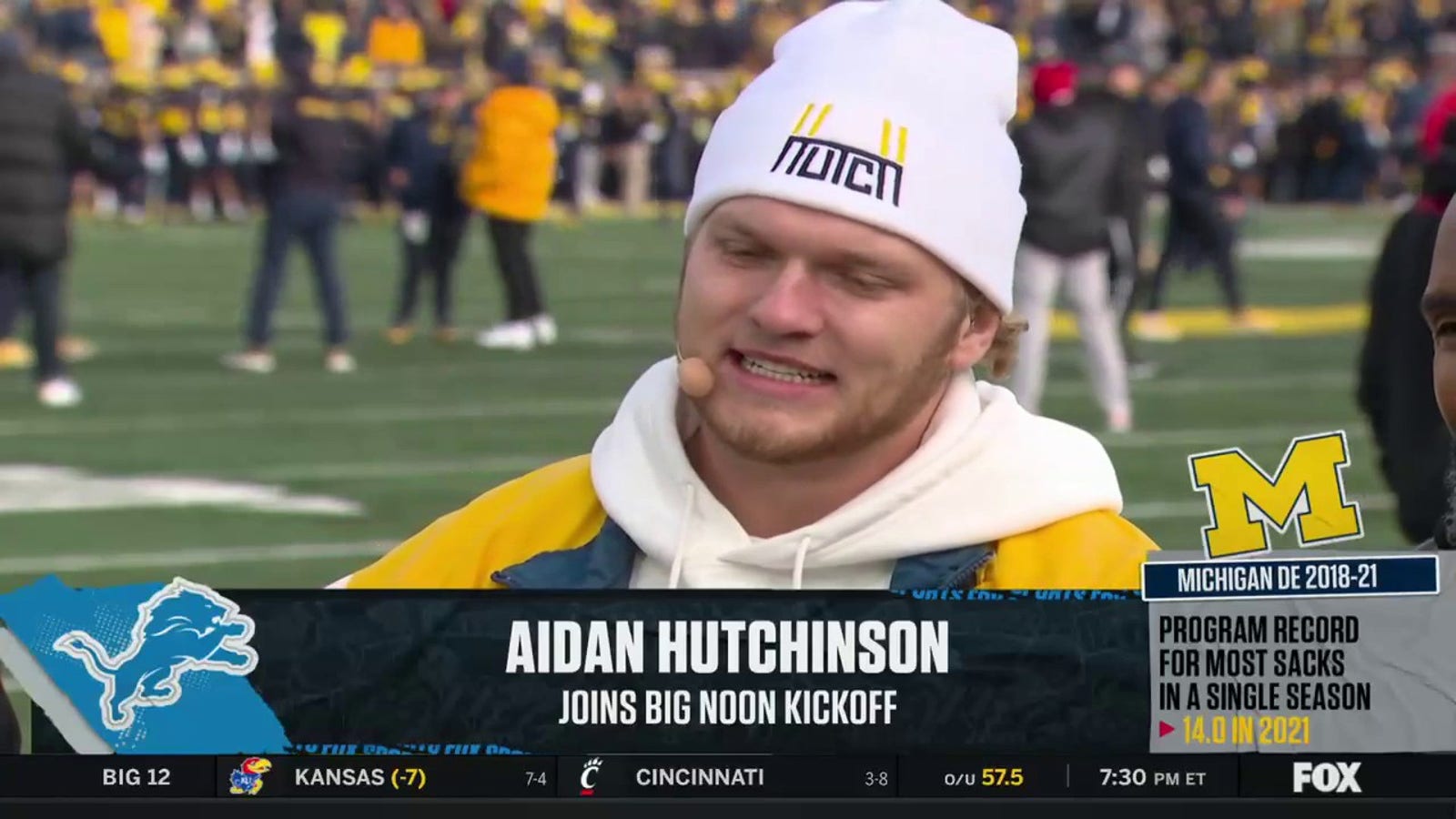
How Michigan built the nation's stingiest defense
ANN ARBOR, Mich. — A sullen and soft-spoken Marvin Harrison Jr. met with reporters in the visiting media room at Michigan Stadium, across the tunnel from where hooting and hollering radiated from the joyous home locker room. Harrison had been Ohio State's bright spot during a 30-24 loss to Michigan that extended the Wolverines' winning streak to three. He led the team with five receptions for 118 yards and a touchdown after being targeted on 30% of throws by quarterback Kyle McCord.
In spite of that production, Harrison was still in disbelief during a brief postgame news conference last Saturday. The plan devised by Michigan defensive coordinator Jesse Minter was like nothing Harrison had ever experienced.
"The safety help they had over the top or inside," Harrison said, "I've never really seen anything like it until today. Just the bracket coverage in the red zone that we got. I definitely got doubled a lot more today than I ever have before."
There are many explanations for how Michigan turned the tide in a rivalry that once handed the Wolverines 15 losses in the span of 16 games from 2004-19, including an 0-5 start against the Buckeyes for head coach Jim Harbaugh. One of them is the defensive overhaul that began when Harbaugh hired Mike Macdonald from his brother's coaching staff with the Baltimore Ravens to replace former coordinator Don Brown, whose scheme had eventually gone stale. Macdonald transformed Michigan into the No. 8 scoring defense in the country during his one highly successful season in Ann Arbor.
When Macdonald returned to the Ravens ahead of the 2022 campaign, Harbaugh's next shrewd decision was to hire a replacement steeped in the same defensive system, which meant finding another rising star with ties to the Ravens. In stepped Minter, whose lone season as Vanderbilt's defensive coordinator was preceded by four years in Baltimore. He could provide the schematic continuity Harbaugh desperately wanted.
"Any time you go somewhere," Minter said, "you assess, ‘What's the thing that's kept this place from reaching the highest goals that you might have?' And particularly it was that game [against Ohio State], you know? There were so many wins and a lot of success [under Harbaugh prior to 2021], a lot of really good defense. The No. 1 defense in the country, top-five [defense in the country]. But is it set up to beat the team that you know you have to beat, that you're gonna play in the last game of the season every year?"
Michigan's defense wasn't built to beat Ohio State when Brown got fired in 2020, but it certainly is now after notching three straight wins over the Buckeyes for the first time this century. The tweaks and fine-tuning of a system installed by Macdonald and honed by Minter the last two years have elevated the Wolverines to the No. 1 scoring defense and No. 2 total defense in the country. Iowa won't be the only team with an elite unit on that side of the ball when this year's Big Ten championship game kicks off at Lucas Oil Stadium on Saturday night (8 p.m. ET on FOX and the FOX Sports app).
Here's a look at the anatomy of Michigan's defense in 2023:
Interior pass rush
On the day Michigan snapped an eight-game losing streak to Ohio State in 2021, edge rusher Aidan Hutchinson turned in a virtuoso performance. The eventual No. 2 overall pick in the NFL Draft racked up an astounding 15 quarterback pressures — which, at that time, was the highest single-game total since Pro Football Focus began collecting data — and three sacks of quarterback C.J. Stroud.
Hutchinson's outburst against the Buckeyes was emblematic of how the Wolverines played defense that season. He and fellow edge rusher David Ojabo, who was projected as a first-round pick before suffering a torn Achilles at pro day, combined for 25 sacks and 117 pressures as the unquestioned focal points of Macdonald's scheme. Everything their new coordinator did was designed to maximize the opportunities of Michigan's elite sack artists.
Since then, the Wolverines have shifted their approach to more of a teamwide pass rush in the absence of such singularly dominant edge players. Nowhere is that more evident than along the interior of Michigan's defensive line, where the steady production of standouts Mason Graham, Kris Jenkins and Kenneth Grant has afforded Minter the luxury of a lower blitz rate to keep more players back in coverage. Minter only blitzed McCord eight times on 31 dropbacks (25.8%) last week.
Entering the Big Ten title game, Michigan boasts four defensive tackles with a pass-rush win rate of 8% or better, according to Pro Football Focus, in what is a significant change from the last two seasons. Graham (17.1%), Jenkins (10.9%), Cam Goode (10%) and Grant (8.1%) have given the Wolverines a more direct path to opposing quarterbacks with nine sacks and 58 pressures combined.
In 2022, when Michigan finished sixth in total defense and seventh in scoring defense during Minter's first season, no interior lineman produced a pass-rush win rate of more than 10.7%, a mark set by Graham as a true freshman. In 2021, when the Wolverines leaned so heavily on Hutchinson and Ojabo, no interior lineman had a better pass-rush win rate than Chris Hinton's tepid 7.7%.
"The rush we've gotten with four, I think, has been really effective," Minter said. "It's been effective on normal downs — more so than previously — and then I definitely think it's been effective on third down. ... I look at the last couple games, and really in crunch time, I feel like our pass rush has won us the game in both of those last games where we've had tight situations in the fourth quarter."
Impact transfers
Regardless of whether Michigan wins the national title, the contributions from impact transfers on both sides of the ball have been critical to the Wolverines' success. Harbaugh and his staff put together the No. 17 transfer portal class in the country between the 2022 and 2023 seasons, according to 247Sports, and eight of the nine arrivals are seeing the field on a weekly basis in one form or another: kicker James Turner (Louisville), cornerback Josh Wallace (UMass), edge rusher Josaiah Stewart (Coastal Carolina), tight end AJ Barner (Indiana), inside linebacker Ernest Hausmann (Nebraska) and offensive linemen LaDarius Henderson (Arizona State), Myles Hinton (Stanford) and Drake Nugent (Stanford).
The defensive reinforcements are proving particularly important for a unit that finished last season with plenty of high-end talent in the starting lineup but lacked the necessary depth to withstand the injuries and attrition of a long season.
This was especially true at inside linebacker, where starters Junior Colson and Michael Barrett were so beat up after winning the Big Ten title in 2022 that they hardly practiced in the buildup to the College Football Playoff, finally retaking the field just a few days before kickoff. The addition of Hausmann, who started seven games as a true freshman for the Cornhuskers that same year, gave recently fired inside linebackers coach Chris Partridge a legitimate third option who could lessen the workload of the aforementioned veterans. Colson's average snap count is down from 51.9 per game last season to 41.5 per game in 2023. Barrett's playing time is down from 44.9 snaps per game in 2022 to 35.3 per game this season.
At the edge rusher position, Stewart seems to have recaptured the level of play he showed while earning Freshman All-American honors at Coastal Carolina in 2021, a year in which he tallied 12.5 sacks and 15.5 tackles for loss. He's graciously accepted a situational pass-rushing role behind starters Braiden McGregor and Jaylen Harrell, but no edge defender on Michigan's roster is a more effective rusher on a per-snap basis. Stewart leads the Wolverines in pass-rush win rate (20%) and is tied for the team lead in quarterback pressures (23) despite ranking fourth in playing time among edge rushers. One member of the Michigan coaching staff said Stewart is the player he'd trust most to rush the quarterback when a game is on the line.
And in the secondary, where Michigan ranks fourth nationally in pass defense, Wallace immediately laid claim to a starting role at the group's biggest position of need. He's played the third-most snaps of any defensive player and has yet to allow a touchdown this season, holding opposing quarterbacks to a 44.8% completion rate and an NFL passer rating of 59.3, according to Pro Football Focus.
"Those three guys have just been huge assets," Minter said. "And it's a great selling point now to the next wave of guys."
Elite cornerbacks
Within the first few plays of last week's win over Ohio State, the strategy Minter and defensive passing game coordinator Steve Clinkscale had cooked up to defend Harrison became quite clear: More often than not, cornerback Will Johnson was going to travel with Harrison and cover college football's best receiver regardless of where he lined up.
The choice reflected Michigan's confidence in a true sophomore who has developed into one of the best corners in the country. A five-star prospect from the Detroit suburbs, Johnson was the crown jewel of Harbaugh's 2022 recruiting class and the No. 15 overall player in the country. He replaced veteran Gemon Green as a starter partway through last season and finished by earning Freshman All-America honors from three media outlets.
At 6-foot-2 and 202 pounds, Johnson gives the Wolverines a bona fide No. 1 corner with enough size, speed and ball skills to contend with someone like Harrison, whose 6-foot-4, 205-pound frame hardly resembles that of his father, a diminutive and lithe Hall of Famer. Last year's alpha corner, DJ Turner II, had the speed and ball skills to duel with Harrison but was a physical mismatch at 5-foot-11 and 179 pounds. As a result, the Wolverines' coverage plan was far more balanced with five defensive backs all defending Harrison for at least one target in 2022.
This year, however, Johnson was in coverage for five of the nine passes McCord threw in Harrison's direction, with no other player defending more than one target. He allowed three receptions for 82 yards and positioned the Wolverines for a touchdown by undercutting an in-breaking route to snag McCord's first interception. It was Johnson's third pick of the season and helped give Michigan an early lead. He enters the Big Ten title game ranked 14th nationally in coverage grade among corners with comparable playing time, according to Pro Football Focus.
"Will did a great job of sort of giving him just a zone look," Minter said. "Almost like a Cover 2 look. But [he was] really able to play inside [leverage] on that knowing he was protected over the top. That was a great play by Will."
If Johnson is the team's best cover corner, then Mike Sainristil is the secondary's most versatile chess piece. A former wide receiver, Sainristil converted to defensive back two seasons ago and quickly secured a spot as the team's starting nickel after Daxton Hill left for the NFL. He's been indispensable ever since.
Minter deployed Sainristil all over the field against Ohio State in a performance that showcased the breadth of his skill set, which has caught the attention of NFL scouts. Sainristil's 58 defensive snaps were split between slot corner (18), perimeter corner (26), box safety (10), edge rusher (3) and free safety (1) while allowing two catches for 16 yards and delivering the biggest hit of the game on tailback TreVeyon Henderson. Sainristil, who has a team-high four interceptions, two of which were returned for touchdowns, was named a second-team All-Big Ten performer by the league's coaches earlier this week.
"I think somebody is going to [draft] him and I think somebody is going to love him as their nickel for a lot of years," Minter said. "And then his ability to also do things on special teams, play some safety, play some corner. I think he's made himself into a really high-end NFL prospect in that regard."
Michael Cohen covers college football and basketball for FOX Sports with an emphasis on the Big Ten. Follow him on Twitter at @Michael_Cohen13.













